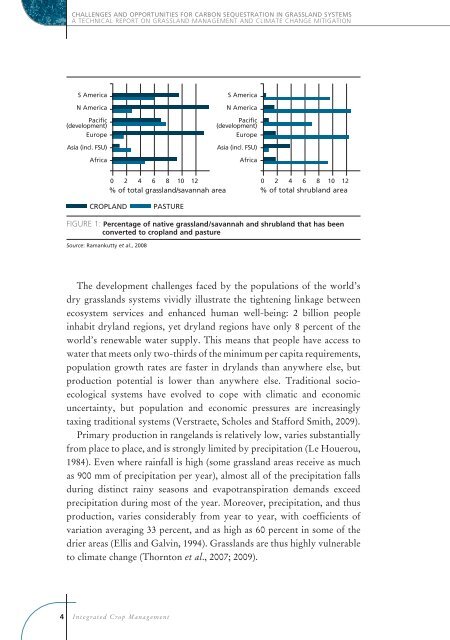Challenges and opportunities for carbon sequestration in ... - FAO
Challenges and opportunities for carbon sequestration in ... - FAO
Challenges and opportunities for carbon sequestration in ... - FAO
You also want an ePaper? Increase the reach of your titles
YUMPU automatically turns print PDFs into web optimized ePapers that Google loves.
<strong>Challenges</strong> <strong>and</strong> <strong>opportunities</strong> <strong>for</strong> <strong>carbon</strong> <strong>sequestration</strong> <strong>in</strong> grassl<strong>and</strong> systemsA Technical Report on Grassl<strong>and</strong> Management <strong>and</strong> Climate Change MitigationS AmericaN AmericaPacific(development)EuropeAsia (<strong>in</strong>cl. FSU)AfricaS AmericaN AmericaPacific(development)EuropeAsia (<strong>in</strong>cl. FSU)Africa0 2 4 6 8 10 12% of total grassl<strong>and</strong>/savannah area0 2 4 6 8 10 12% of total shrubl<strong>and</strong> areacropl<strong>and</strong>pastureFigure 1: Percentage of native grassl<strong>and</strong>/savannah <strong>and</strong> shrubl<strong>and</strong> that has beenconverted to cropl<strong>and</strong> <strong>and</strong> pastureSource: Ramankutty et al., 2008The development challenges faced by the populations of the world’sdry grassl<strong>and</strong>s systems vividly illustrate the tighten<strong>in</strong>g l<strong>in</strong>kage betweenecosystem services <strong>and</strong> enhanced human well-be<strong>in</strong>g: 2 billion people<strong>in</strong>habit dryl<strong>and</strong> regions, yet dryl<strong>and</strong> regions have only 8 percent of theworld’s renewable water supply. This means that people have access towater that meets only two-thirds of the m<strong>in</strong>imum per capita requirements,population growth rates are faster <strong>in</strong> dryl<strong>and</strong>s than anywhere else, butproduction potential is lower than anywhere else. Traditional socioecologicalsystems have evolved to cope with climatic <strong>and</strong> economicuncerta<strong>in</strong>ty, but population <strong>and</strong> economic pressures are <strong>in</strong>creas<strong>in</strong>glytax<strong>in</strong>g traditional systems (Verstraete, Scholes <strong>and</strong> Staf<strong>for</strong>d Smith, 2009).Primary production <strong>in</strong> rangel<strong>and</strong>s is relatively low, varies substantiallyfrom place to place, <strong>and</strong> is strongly limited by precipitation (Le Houerou,1984). Even where ra<strong>in</strong>fall is high (some grassl<strong>and</strong> areas receive as muchas 900 mm of precipitation per year), almost all of the precipitation fallsdur<strong>in</strong>g dist<strong>in</strong>ct ra<strong>in</strong>y seasons <strong>and</strong> evapotranspiration dem<strong>and</strong>s exceedprecipitation dur<strong>in</strong>g most of the year. Moreover, precipitation, <strong>and</strong> thusproduction, varies considerably from year to year, with coefficients ofvariation averag<strong>in</strong>g 33 percent, <strong>and</strong> as high as 60 percent <strong>in</strong> some of thedrier areas (Ellis <strong>and</strong> Galv<strong>in</strong>, 1994). Grassl<strong>and</strong>s are thus highly vulnerableto climate change (Thornton et al., 2007; 2009).4Integrated Crop Management

















